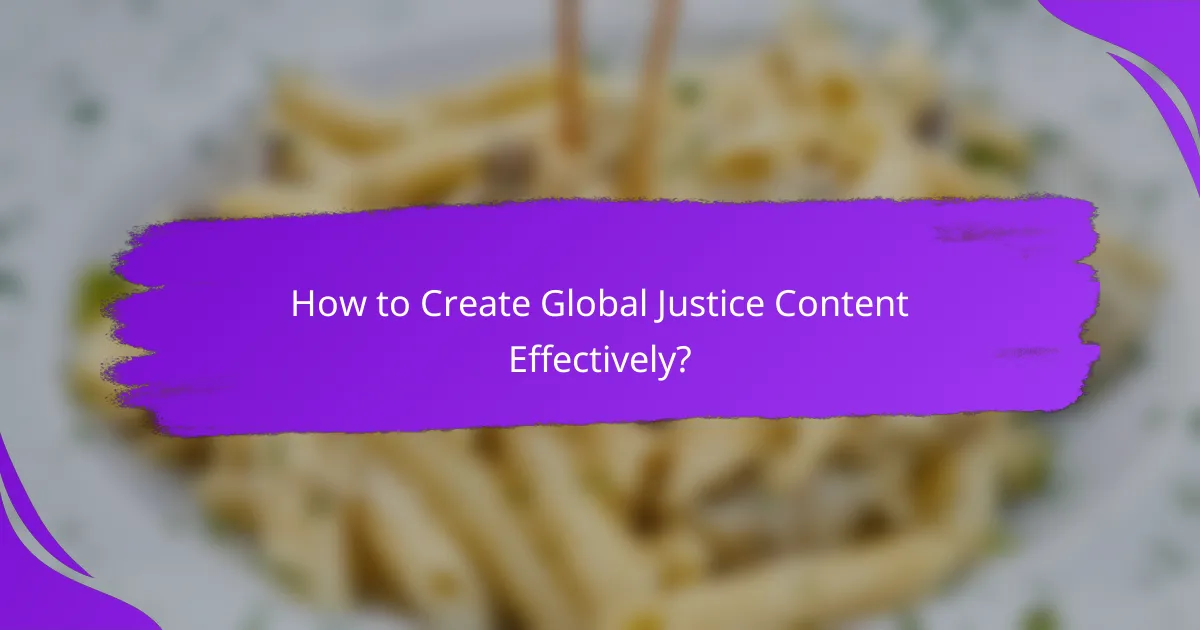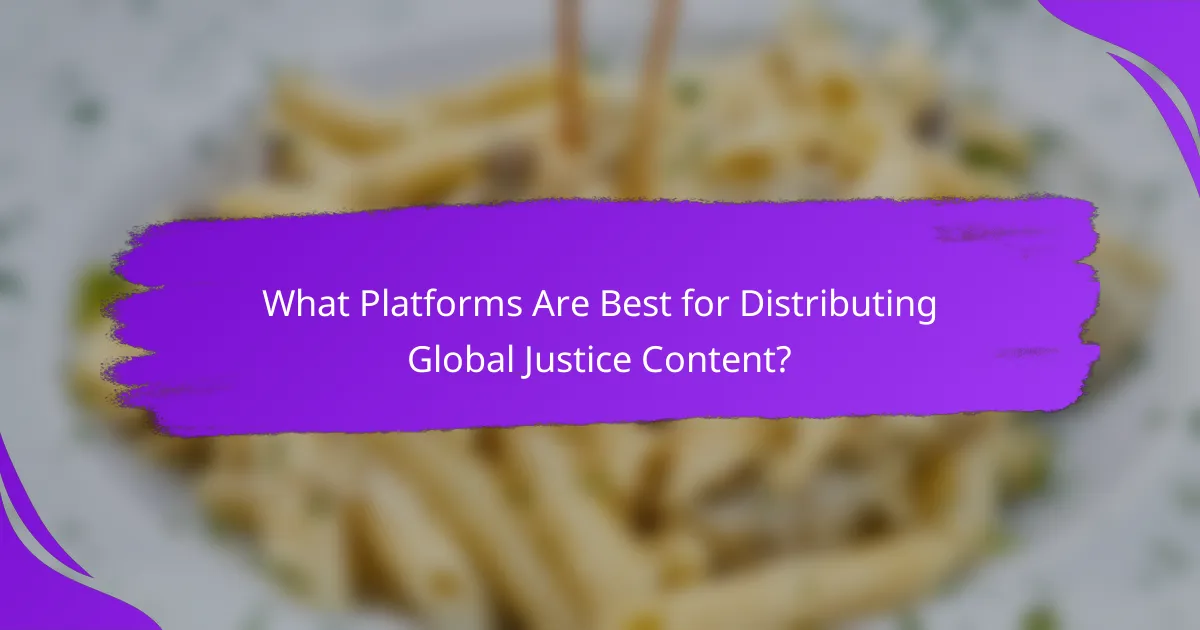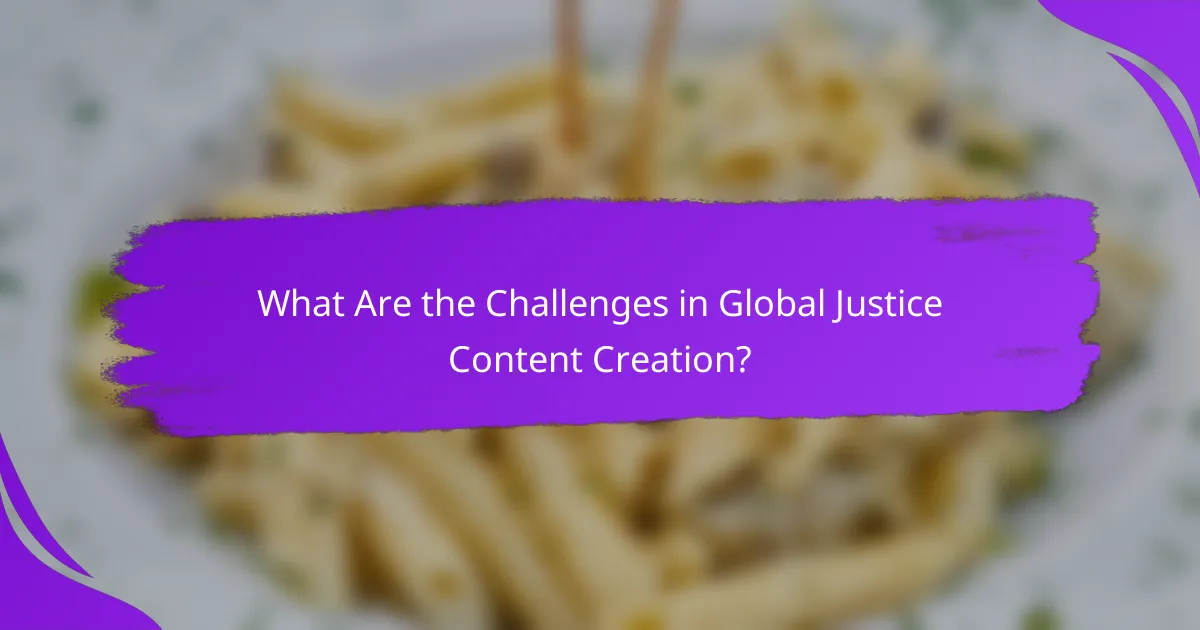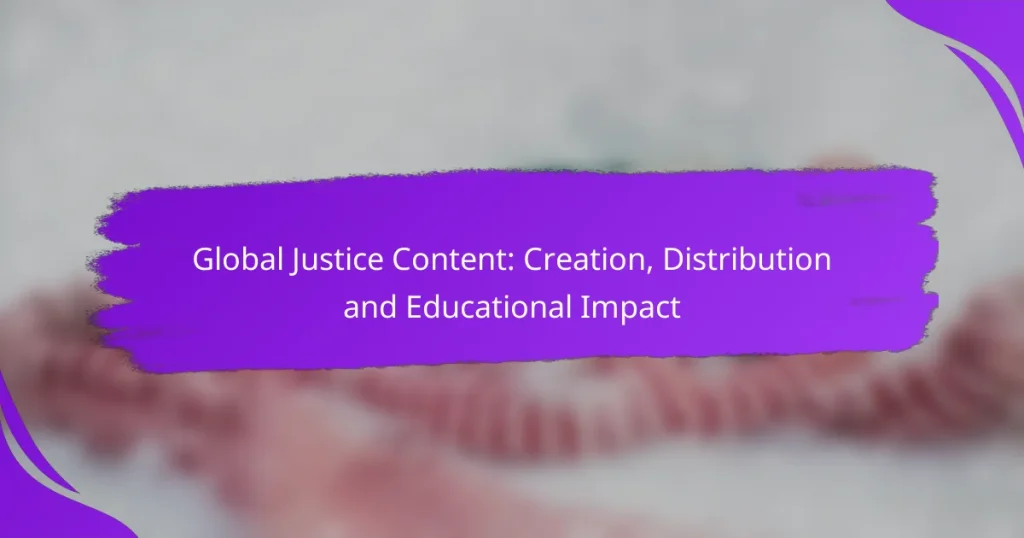Global justice content plays a crucial role in raising awareness and fostering understanding of pressing social issues across diverse audiences. By effectively creating and distributing this content, we can enhance educational experiences, promote civic engagement, and encourage critical thinking among learners. Through thoughtful storytelling and community involvement, such content becomes a powerful tool for inspiring social responsibility and informed citizenship.

How to Create Global Justice Content Effectively?
Creating global justice content effectively involves understanding the issues at hand and communicating them in a way that resonates with diverse audiences. It requires a thoughtful approach that combines storytelling, diverse perspectives, multimedia, community engagement, and cultural sensitivity.
Utilizing storytelling techniques
Storytelling is a powerful tool for conveying complex global justice issues. By framing narratives around real-life experiences, you can create emotional connections that engage audiences more deeply than mere facts and figures. Consider using case studies or personal testimonies to illustrate the impact of injustice.
When crafting your story, focus on character development and conflict resolution. Highlight the struggles and triumphs of individuals or communities affected by global injustices, which can inspire empathy and action among your audience.
Incorporating diverse perspectives
Incorporating diverse perspectives is crucial for a comprehensive understanding of global justice issues. Engage voices from various backgrounds, including marginalized communities, to ensure that your content reflects a range of experiences and viewpoints. This not only enriches the narrative but also fosters inclusivity.
Consider conducting interviews or collaborating with local activists and experts. Their insights can provide authenticity and depth to your content, making it more relatable and impactful for your audience.
Leveraging multimedia formats
Utilizing multimedia formats can enhance the accessibility and engagement of your global justice content. Incorporate videos, infographics, and podcasts to present information in varied ways that cater to different learning styles. For instance, a short documentary can vividly illustrate a community’s struggle for justice.
When using multimedia, ensure that it complements your written content rather than overwhelming it. A balanced approach can help maintain focus while providing richer context and understanding.
Engaging with local communities
Engaging with local communities is essential for creating relevant and impactful global justice content. This involvement can take many forms, such as hosting workshops, attending community meetings, or collaborating on projects. Such engagement fosters trust and ensures that the content accurately reflects community needs and priorities.
Additionally, consider creating platforms for community members to share their stories and perspectives. This not only empowers them but also enriches your content with authentic voices and experiences.
Ensuring cultural sensitivity
Ensuring cultural sensitivity is vital when creating global justice content. Be aware of cultural norms, values, and historical contexts that may influence how your message is received. Avoid stereotypes and generalizations that can alienate or misrepresent communities.
Research and consult with cultural experts or community leaders to validate your content. This practice can help you navigate complex cultural landscapes and foster respect and understanding among diverse audiences.

What Platforms Are Best for Distributing Global Justice Content?
Effective distribution of global justice content relies on platforms that maximize reach and engagement. Social media, nonprofit websites, educational platforms, and blogs each offer unique advantages for sharing impactful narratives and resources.
Social media channels
Social media channels like Facebook, Twitter, and Instagram are powerful tools for distributing global justice content. They allow for rapid sharing and engagement, helping to raise awareness and mobilize support for various causes.
When using social media, focus on creating visually appealing posts and using relevant hashtags to increase visibility. Engaging with followers through comments and shares can also amplify your message and foster community involvement.
Nonprofit organization websites
Nonprofit organization websites serve as credible platforms for distributing global justice content. These sites often provide in-depth resources, reports, and calls to action that can educate visitors about specific issues.
To effectively utilize nonprofit websites, ensure that content is easily accessible and well-organized. Incorporating multimedia elements like videos and infographics can enhance user engagement and understanding of complex topics.
Educational platforms like Coursera
Educational platforms such as Coursera and edX are excellent for distributing global justice content in a structured format. They offer courses that can educate a wide audience on various justice-related topics, often featuring expert instructors.
When creating content for these platforms, focus on developing comprehensive courses that include assessments and interactive components. This approach not only informs but also encourages active participation and deeper learning.
Blogs and online publications
Blogs and online publications provide a flexible medium for sharing global justice content through articles, opinion pieces, and research summaries. They can reach niche audiences interested in specific issues and foster discussions around them.
To maximize impact, consider guest posting on established blogs or collaborating with online publications that align with your mission. Regularly updating content and engaging with readers through comments can help build a loyal audience and encourage further sharing of your message.

What Educational Impact Does Global Justice Content Have?
Global justice content significantly influences education by enhancing awareness of social issues, fostering civic engagement, and developing critical thinking skills among learners. This type of content serves as a vital tool for promoting social responsibility and informed citizenship.
Raising awareness about social issues
Global justice content effectively raises awareness about pressing social issues such as poverty, inequality, and human rights violations. Through documentaries, articles, and interactive media, individuals gain insights into the complexities of these challenges, often leading to a deeper understanding of their local and global contexts.
For example, a documentary highlighting the effects of climate change on vulnerable communities can motivate viewers to learn more and take action. Educational institutions can incorporate such content into their curricula to enhance students’ awareness and empathy towards diverse social issues.
Encouraging civic engagement
Global justice content encourages civic engagement by inspiring individuals to participate in community initiatives and advocacy efforts. When people are informed about social injustices, they are more likely to get involved in local activism, volunteer work, or policy-making processes.
For instance, campaigns that focus on voting rights or environmental justice can mobilize citizens to engage in grassroots movements. Educational programs can leverage this content to teach students the importance of civic responsibility and the impact of collective action.
Promoting critical thinking skills
Engaging with global justice content promotes critical thinking skills by challenging individuals to analyze complex issues and consider multiple perspectives. This type of content often presents conflicting viewpoints, encouraging learners to evaluate evidence and form reasoned opinions.
In classrooms, discussions around global justice topics can stimulate debates and collaborative projects, allowing students to practice critical analysis. Educators can facilitate this by asking open-ended questions and encouraging students to research various aspects of a social issue, fostering a culture of inquiry and reflection.

What Are the Key Metrics for Measuring Impact?
Key metrics for measuring impact in global justice content include engagement rates, content reach, impressions, and feedback. These metrics help assess how effectively the content resonates with audiences and contributes to educational goals.
Engagement rates
Engagement rates reflect how actively users interact with content, typically measured through likes, shares, comments, and time spent on the page. High engagement indicates that the content is resonating with the audience, while low engagement may suggest a need for improvement.
To calculate engagement rates, divide the total interactions by the total reach or impressions and multiply by 100. For example, if a post receives 200 interactions out of 1,000 impressions, the engagement rate is 20%.
Content reach and impressions
Content reach refers to the number of unique users who see the content, while impressions count how many times the content is displayed, regardless of whether it was clicked. Understanding both metrics is crucial for evaluating the visibility of global justice content.
For effective measurement, track these metrics across various platforms, as they can vary significantly. For instance, social media platforms may show higher reach but lower impressions compared to email newsletters, which might have fewer unique viewers but higher engagement.
Feedback and testimonials
Feedback and testimonials provide qualitative insights into the impact of content. Gathering user opinions through surveys, comments, or direct messages can reveal how the content influences perceptions and actions regarding global justice issues.
Encourage feedback by creating easy-to-use forms or prompts at the end of content pieces. Highlighting positive testimonials can also enhance credibility and encourage further engagement from new users.

What Are the Challenges in Global Justice Content Creation?
Global justice content creation faces several challenges, including cultural sensitivity, accessibility, and the need for accurate representation. These factors can complicate the development and distribution of content that resonates across diverse audiences.
Cultural Sensitivity in Content Creation
Cultural sensitivity is crucial in global justice content creation. It requires understanding and respecting the diverse backgrounds and beliefs of different communities. Content creators must avoid stereotypes and ensure that their messaging aligns with the values of the target audience.
To achieve cultural sensitivity, research is essential. Engaging with local communities and incorporating their perspectives can enhance authenticity. For instance, using local languages or dialects can make content more relatable and impactful.
Accessibility and Inclusivity
Accessibility and inclusivity are vital for ensuring that global justice content reaches a broad audience. This includes making content available in various formats, such as text, audio, and video, to accommodate different preferences and needs. Additionally, considering disabilities in design can enhance usability.
For example, providing subtitles for videos and ensuring websites are navigable for screen readers can significantly improve access. Content creators should also consider language barriers by offering translations in multiple languages, which can broaden their reach.
Accurate Representation and Ethical Considerations
Accurate representation is essential in global justice content to avoid perpetuating misinformation or biases. Content creators must strive for fairness and objectivity, particularly when discussing sensitive topics like human rights or social justice issues.
Ethical considerations should guide the content creation process. This includes obtaining informed consent when using personal stories or images and being transparent about the sources of information. Regularly reviewing and updating content to reflect current realities can also help maintain accuracy and relevance.

